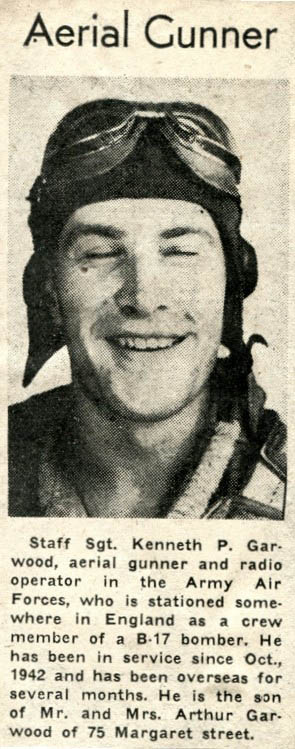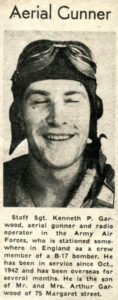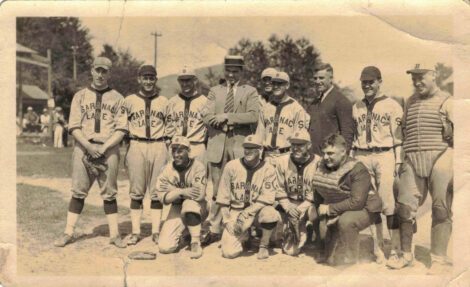POW Garwood comes home
The Enterprise, June 8, 1945

The children’s play park and basketball courts located at the corner of Broadway and Bloomingdale Avenue in Saranac Lake are dedicated to former German Prisoner of War Kenneth Garwood.
I am happy to say that I was a friend of Ken Garwood. I covered village board meetings when he was a village trustee and listened when he would advocate for a play park to be established in his section of the village. He was handsome and speaking as a trustee was articulate, polite and precise.
He and his wife Gwen Sellner and their six children, John, Joel, Ken Jr., Linda, Diane and Linda, lived at 24 Cedar St.
Ken was a village trustee for eight years – 1958 to 1961 and 1968 to 1973 — serving with Bill Wigger, John Morgan (no, not that John Morgan), Francis Gladd, Mayor Tony Anderson and probably with others as terms overlapped.
“‘The village looks pretty good and I’m just beginning to get used to it again,’ said Tech. Sgt. Kenneth P. Garwood on his return to Saranac Lake after 11 months of internment as a German prisoner of war.
“Sgt. Garwood arrived here Tuesday evening and will spend 60 days with his parents, Mr. and Mrs. Arthur Garwood of 75 Margaret Street. Although he has already gained 30 pounds he lost on a three months’ enforced march back and forth across Germany, the flier is going to make up on home cooking for all he missed while a prisoner and he doesn’t want any potatoes.
“Sgt. Garwood, who holds the Air Medal, was serving as a radio operator and aerial gunner on a B-17 when on June 20, 1944 his plane was shot up by anti-aircraft fire and fighter planes following a raid on Magdeburg, Germany. The fliers had dropped their bombs when attacked by enemy aircraft and they were forced to parachute from their crippled plane.”
[Following is a clip from a column I wrote about Sgt. Garwood in 2007. As you will read, he was shot down previously, but what you will not read is this: those fliers never parachuted before, had some minimum training and did not usually wear their parachutes because they were too bulky over flak vests. They wore a harness that could be quickly attached to the chute.]
“Sgt. Garwood landed near Magdeburg and was unhurt in the jump. He was caught by German civilians and of the treatment by them he said, ‘it was pretty rough.’ They were taken then by civilian police and finally turned over to the German Army.
“Transported to Frankfort the flier and other prisoners were questioned and interrogated and received fair treatment. Then they were put into box cars with twenty-two men to half a car and guarded by soldiers. About 135 captives were on Sgt. Garwood’s plane.
“The airman’s group were taken Stalag Luft 4 at Belgard in Northeastern Germany and there he remained until Feb. 6 of this year. For the first few months of prison life the men reported three times a day for roll call and had nothing else to do.
“Towards the end of the summer books and sports equipment were sent to the camp for them by the YMCA and once a week they were given one Red Cross parcel for two men. The average daily diet at the camp, said Sgt. Garwood, was hot water for breakfast with which they mixed their powdered coffee from Red Cross kits, one quarter of a loaf of bread a day when it was available, ersatz soup for lunch and boiled potatoes for the evening dinner.
“Towards the beginning of 1945 the prisoners began to realize from their guards that the Allied Armies were approaching and on February 6th they were ordered from camp and began their enforced march from the path of the Russian Army.
“‘That was plenty rugged, although we lost only one man,’ [from his unit] said Sgt. Garwood of the trek across Germany. For three months the men marched covering 15 to 20 miles a day. During the ordeal the food was scarce and was mainly hot water and potatoes.
“After crossing the Elbe River the prisoners were marched back again out of the way of the British and American armies and it began to look pretty bad although they had been warned not to try to escape. On May 2 the prisoners were liberated by a British reconnaissance tank corps that finally caught up with them.
“The men made their own way across to friendly lines and to the Luneberg reception center. From there Sgt. Garwood was flown to Brussels then by train to LeHavre, France, by boat to the U.S.A. and finally home.
“Sgt. Garwood entered the service in October, 1942 and had been overseas stationed in England since late February, 1944. After his furlough he will report to Atlantic City, N.J., for reassignment.”
–
Congressional record
–
“Tech. Sgt. Kenneth P. Garwood, of 45 Cedar Street, Saranac Lake, is a World War II Air Force veteran and former prisoner of war of the Germans, and therein lays an incredible tale.
“Ken went into the 96th Bomb Group of the 8th Air Force after joining the service at age 20. First, however, he went to basic training at Maxwell Field in Montgomery, Al; to Radio School in Sioux Falls, S.D.; to Gunnery School in Texas and finally more training at Drew Field in Florida.
“His crew delivered a new B-17 to Ireland for another crew and then went on to his base in England where the B-17 outfit he trained with got their own plane and started bombing runs over Germany.”
–
Shot down on first raid
–
“On the first raid in May 1944, Sgt. Garwood’s plane was shot down over the English Channel. He radioed an SOS, they ditched, a British Air-Sea Rescue team responded and the entire crew was plucked out of the water within 13 minutes.
“Garwood and his crew were not so lucky when only one month later, on their 15th bombing mission they were shot down over Madenburg, Germany. He later saw the plane explode and the oniy person not accounted for was the engineer who was the ball turret gunner.
“‘Civilians rounded us up and beat the hell out of us before the soldiers came” Garwood said, “then took us to an interrogation camp near Frankfort and later to a POW camp in Northern Germany, Stalag Luft IV.'”
–
The three-month march
–
“The story of the Bataan Death by the Japanese in WWII has been well documented but the forced March by the Germans has rarely been told.
“Sgt. Garwood was one of 9,500 prisoners who were part of the German forced march. They marched night and day for three months, Garwood said, eating bread and potatoes, sleeping in barns, while once in a while getting food at a farm house.
“Now that story is in the U.S. Congressional Record, entered there by U.S. Senator John Warner on the occasion of the 50th Anniversary of that march on May 8, 1995. Here are excerpts from the story as presented by Senator Warner:
“It is appropriate to commemorate our World War II POW’s by describing one incident from the War. This is the story of an 86-day, 488-mile forced march that commenced at a POW camp known as Stalag Luft IV, near Grosstychew, Poland on February 6, 1945 and ended in Halle, Germany on April 26, 1945. The ordeal of 9,500 men, most of whom were U.S. Army Air Force Bomber Command non-commissioned officers, who suffered through incredible hardships on the march, yet survived, stand as an everlasting testimonial to the triumph of the American spirit.
“The 86-day march was by all accounts savage. Men who for months, and in some cases years, had been denied proper nutrition, personal hygiene and medical care were forced to do something that would be difficult for well-nourished, healthy infantry soldiers.
“A number of soldiers on the march did not survive. Others suffered amputations of limbs, while others endured maladies that remained or will remain with them for the rest of their lives. These men from Stalag Luft IV enduring unbelievably inhumane conditions, walked, limped and in some cases crawled onward until they reached the end of their march, with the liberation by the American 104th Infantry Division on April 26, l945.”
“At the opening of his remarks. Senator Warner said: ‘Unfortunately the story of the men of Stalag Luft IV, replete with tales of the selfless and often heroic deeds of prisoners looking after other prisoners and helping each other to survive under deplorable conditions is not well known. I therefore rise today to bring their saga of victory over incredible adversity to the attention of my colleagues.’
“Well, Ken Garwood returned to Saranac Lake at the ripe old age of 23 in 1945 (he would not be 24 until that November), married his sweetheart, Gwen Sellner in 1946 and settled down to raise a large family. They have six children: John, Joel, Ken Jr., Linda (Schalm), Diane (Hallaway), and Lisa (Leonidas).
“Ken was with Scheefer’s Jewelers for 58 years and served the village in many roles including, but not limited to, Village Trustee and member of the Village Planning Board. The playground at the corner of Broadway & Ampersand Avenue is named for Ken because he was the main drive behind its establishment.”




